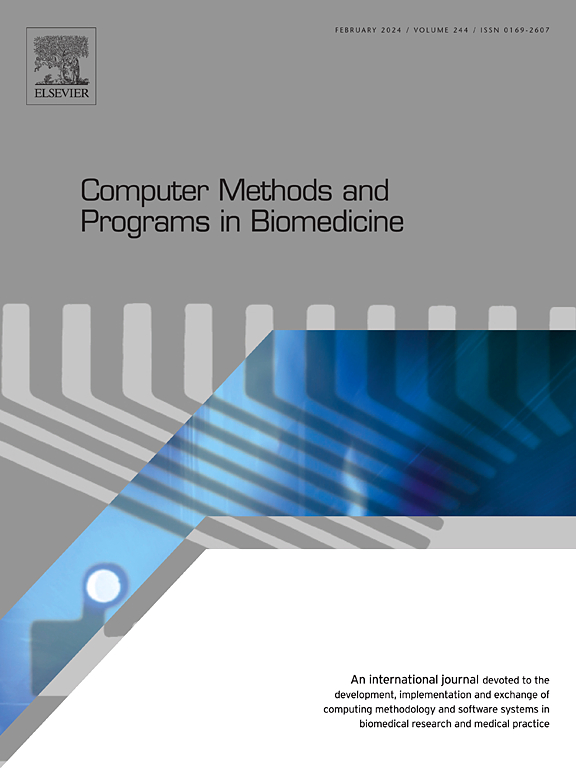Computational methods used to investigate atherosclerosis progression in coronary arteries: structural FEA, CFD or FSI
IF 4.9
2区 医学
Q1 COMPUTER SCIENCE, INTERDISCIPLINARY APPLICATIONS
引用次数: 0
Abstract
Background and objectives
In recent years, computational simulations have emerged as valuable tools for the evaluation of atherosclerosis progression in coronary anatomies, although only a few studies have utilized more realistic Fluid-Structure Interaction (FSI) simulations. This work aims to compare the results of Computational Fluid Dynamics (CFD), Structural Finite Element Analysis (structural FEA) and FSI simulations in order to assess differences in plaque progression indices estimation.
Methods
We performed structural FEA, CFD and FSI on five patient-specific epicardial coronary anatomies using the commercial software LS-Dyna. To account for the vessel pre-stress, the zero-pressure configuration was calculated for each anatomy with an inverse elastostatic algorithm. CFD, structural FEA and FSI simulations were performed applying boundary conditions based on physiological values.
Results
The comparison between structural FEA and FSI showed similar stress distribution and vessel expansions, with differences found only in the distal parts of the coronaries, where pressure reduction due to pressure loss affects the vessel walls. The elastic walls of the coronaries impact blood flow, resulting in a more disturbed flow. However, time averaged wall shear stress (TAWSS) and oscillatory shear index (OSI) distributions are similar across each coronary between CFD and FSI; TAWSS is slightly higher in CFD while OSI peaks are higher in FSI.
Conclusion
In conclusion, given the significantly higher computational costs of FSI, we believe that CFD and structural FEA offer a more practical and cost-effective approach, providing results comparable to those of FSI, making them preferable options.
用于研究冠状动脉粥样硬化进展的计算方法:结构有限元分析、CFD或FSI
背景和目的近年来,计算模拟已成为评估冠状动脉粥样硬化进展的有价值的工具,尽管只有少数研究利用了更真实的流体-结构相互作用(FSI)模拟。本研究旨在比较计算流体动力学(CFD)、结构有限元分析(Structural Finite Element Analysis, Structural FEA)和FSI模拟的结果,以评估斑块进展指数估计的差异。方法应用商业软件LS-Dyna对5例患者心外膜冠状动脉解剖进行结构有限元分析、CFD和FSI分析。考虑到血管的预应力,零压力配置计算了每个解剖与反弹性静力学算法。采用基于生理值的边界条件进行了CFD、结构有限元和FSI模拟。结果结构FEA和FSI的比较显示应力分布和血管扩张相似,差异仅在冠状动脉远端部分发现,其中压力损失导致的压力降低影响血管壁。冠状动脉的弹性壁会影响血液流动,导致血流更加紊乱。然而,时间平均壁剪应力(TAWSS)和振荡剪切指数(OSI)分布在CFD和FSI之间的每个冠状动脉是相似的;CFD中的TAWSS略高,而FSI中的OSI峰值更高。综上所述,考虑到FSI的计算成本明显较高,我们认为CFD和结构有限元是一种更实用、更经济的方法,可以提供与FSI相当的结果,是更可取的选择。
本文章由计算机程序翻译,如有差异,请以英文原文为准。
求助全文
约1分钟内获得全文
求助全文
来源期刊

Computer methods and programs in biomedicine
工程技术-工程:生物医学
CiteScore
12.30
自引率
6.60%
发文量
601
审稿时长
135 days
期刊介绍:
To encourage the development of formal computing methods, and their application in biomedical research and medical practice, by illustration of fundamental principles in biomedical informatics research; to stimulate basic research into application software design; to report the state of research of biomedical information processing projects; to report new computer methodologies applied in biomedical areas; the eventual distribution of demonstrable software to avoid duplication of effort; to provide a forum for discussion and improvement of existing software; to optimize contact between national organizations and regional user groups by promoting an international exchange of information on formal methods, standards and software in biomedicine.
Computer Methods and Programs in Biomedicine covers computing methodology and software systems derived from computing science for implementation in all aspects of biomedical research and medical practice. It is designed to serve: biochemists; biologists; geneticists; immunologists; neuroscientists; pharmacologists; toxicologists; clinicians; epidemiologists; psychiatrists; psychologists; cardiologists; chemists; (radio)physicists; computer scientists; programmers and systems analysts; biomedical, clinical, electrical and other engineers; teachers of medical informatics and users of educational software.
 求助内容:
求助内容: 应助结果提醒方式:
应助结果提醒方式:


